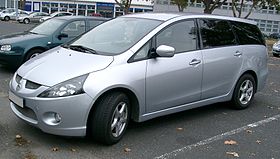Mitsubishi Grandis
| Mitsubishi Grandis | |
|---|---|
 | |
| Overview | |
| Manufacturer | Mitsubishi Motors China Motor Corporation |
| Also called | Mitsubishi Space Wagon |
| Production | 2003–2011 |
| Assembly | Nagoya Plant, Okazaki, Aichi Japan Laem Chabang, Thailand Yang Mei, Taiwan Cainta, Rizal, Philippines |
| Designer | Olivier Boulay |
| Body and chassis | |
| Class | Large MPV |
| Body style | 5-door MPV |
| Layout | Front engine, FWD/4WD |
| Related | Mitsubishi Savrin Mitsubishi Outlander |
| Powertrain | |
| Engine | 4G69 2.4 L I4 MIVEC VW 2.0 L I4 DI-D |
| Transmission | 5-speed manual 4-speed INVECS-II transmission(petrol) 6-speed manual (diesel) |
| Dimensions | |
| Wheelbase | 2,830 mm (111.4 in) |
| Length | 4,765 mm (187.6 in) |
| Width | 1,795 mm (70.7 in) |
| Height | 1,655–1,700 mm (65.2–66.9 in) |
| Curb weight | 1,655–1,725 kg (3,649–3,803 lb) |
| Chronology | |
| Predecessor | Mitsubishi Chariot |
The Mitsubishi Grandis is a seven seat MPV built by Mitsubishi Motors to replace its Chariot/Space Wagon/Nimbusline. It was launched on May 14, 2003 and was sold in Japan, Asia, Europe, Oceania, Mexico, Honduras, Jamaica, and South America.[1] Engines available were a 2.4-litre four-cylinder and a Volkswagen-sourced 2.0-litre turbodiesel(not available in Jamaica), badged DI-D rather than TDI as Volkswagen denotes it.
The exterior styling was based loosely on designer Olivier Boulay's earlier Mitsubishi Space Liner,[2] a monobox four-seat concept vehicle with centre-opening "suicide doors", first exhibited at the Tokyo Motor Show in 2001.[3]
It was the first all new vehicle featuring the company's new common "face", comprising a curved lower grille edge and a sharp crease rising up the leading edge of the bonnet from the prominent corporate badge.[4] It shared its platform with the Mitsubishi Airtrek minus the increased ground clearance.[citation needed]
The Grandis was also the basis for the Mitsubishi FCV (Fuel Cell Vehicle) concept, powered by a fuel celltechnology developed by then controlling shareholder DaimlerChrysler. DCX's "FC System" uses a fuel cell stack to replenish an array of NiMH batteries from 117 litres of compressed hydrogen storage.[5]
It won the Best MPV award at the Bangkok International Motor Show from 2005 to 2010.[6]
During March 2009, it saw the cancellation of this model in the Japanese market, marking the end of the Chariot name after 26 years of production.
For 2011, it was discontinued globally.
Annual production and sales
| Year | Production | Sales | |
|---|---|---|---|
| Japan | Overseas | ||
| 2003 | 28,821 | 23,834 | 3,574 |
| 2004 | 19,173 | 5,247 | 14,352 |
| 2005 | 29,466 | 4,490 | 24,507 |
| 2006 | 17,928 | 1,756 | 16,870 |
| 2007 | 15,549 | 674 | 15,161 |
| 2008 | 8,583 | 281 | 8,283 |

No comments:
Post a Comment